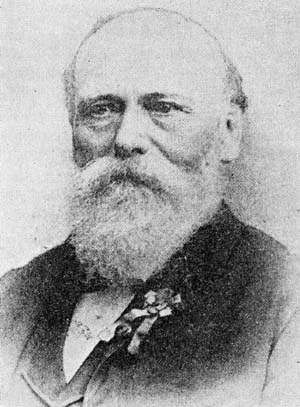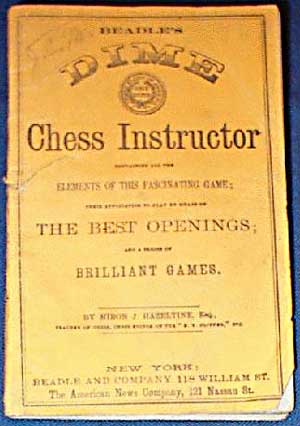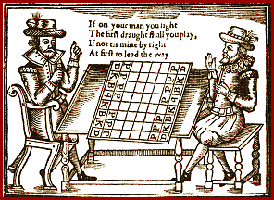|

Miron James Hazeltine
I was looking at Google Book's scan of William Lewis' 1819
reprint of the Calabrian - the book of Greco's manuscripts. While it
wasn't completely clear, I got the impression that the actual book that
was scanned originally came from the library of Miron J. Hazeltine. While
his name isn't totally unfamiliar to me - I knew him as a chess writer and
journalist as well as a collector - I really didn't know much about him. A
little time with Google let me place him a bit more relevantly in the
hierarchy of 19th century chess.
Miron James Hazeltine was born on November 13, 1824 in the tiny
town of Rumney, New Hampshire. His parents, James and Lydia (Steams)
Hazeltine were of German origins. Although he entered Amherst College, a
small exclusive college in Amherst Massachusetts, in 1847, due to an
accident in the school gymnasium in which Hazeltine was severely injured,
he had to drop out of school in 1849. The injury left him a semi-invalid
for life. Hazeltine eventually moved to Lowell, Massachusetts where
he lived for four year while studying law. He married Hanna M. Bryant in
1853. Together they had seven children. He then moved to New York City
where he took a position as principal of the Clinton Institute, a private
academy, from 1859-1861. He moved to Campton Village, New Hampshire, in
the late 1860's and became a Justice of the Peace in 1871. His last move
was to
Thornton, New Hampshire, where he died on
February 24, 1907. Noteworthy is that Hazeltine was also a classics
scholar and made translations of the poems of 6th century B.C.
Greek lyric poet, Anacreon.
More relevant to this journal are Hazeltines chess connections.

Hazeltine is generally credited with having had the first newspaper chess
column in the U.S. in the New York Saturday Courier February
3, 1855 issue but it would be his next chess column, started in August
1856 in the New York Clipper, that would become his life's
work. According to
Bill Wall, he never missed a single issue in the 51 years that his
column appeared there (1856-1907). Also, according to Mr. Wall, Hazeltine
is the first writer to leave out the word "to" in game scores, changing
for example "P to K4" into "P-K4."
Miron Hazeltine's contribution to chess, since his playing strength seems
unknown, was, as opposed to most of his contemporaries, in the literary
field. His Clipper column has been the source of many games that would
have otherwise been lost. On the
Michigan Chess Association site, that wonderful chess historian,
Neil R. Brennen, opines:
The Michigan Chess Association (MCA) has been supporting chess in Michigan
continuously since its founding in 1931.” So reads the first sentence on
the “About the MCA” webpage at
www.michess.org, and no one in Michigan
doubts the truth of the statement. However, there was chess in Michigan
before 1931, and there was even a state association to support it.
What little we know of this predecessor group, the Michigan State Chess
Association, we owe to New York Clipper chess columnist Miron J.
Hazeltine. The chess editor not only featured material on Michigan chess
in his column, he also carefully preserved a detailed report from an
unidentified Michigan newspaper on the 1870 MSCA tournament on pages 126
to 128 of his Scrapbook number 65. I’ll use the phrase “scrapbook article”
when referring to this newspaper tournament report.
Again, according to
Bill Wall, Hazeltine had one of the largest chess libraries, around
600 volumes, in the U. S. at the time of his death in 1907.

Hazeltine was also an author of chess books. His most notable one was
Brevity and brilliancy in chess: A collection of games ... with scientific
problems. Culled from the whole range of chess literature, 1866. But
he also authored a volume, entitled Chess Instructor, for
the fashionable "Dime Novel" company, Beadle.
Beadle was established in 1859 in New York by two brothers, Irwin and
Erastus Beadle. Their concept, the Dime Novel was an instant success and
they flourished even during the Civil War. Their Dime series wasn't
restricted to novels but extended into biographies, sports, music,
and other topics.
Hazeltines booklet was published twice by Beadle. The first edition,
released on December 15, 1860, was a small sized edition comprised of 50
pages. The second edition was of standard size and 80 pages, including 2
of advertisements. The booklet was published a third time in 1898 (with 50
pages) by James Sullivan; M. J. Ivers & Co. publisher
Although David Lawson cited two examples of Hazeline writing about Judge
Meek in the May 2, 1867 issue of the Macon Telegraph, one of which
mentions the 1st American Chess Congress, it seems clear that Hazeltine
neither wrote for the Macon Telegraph nor attended the Congress.
In the Macon Telegraph of May 2, 1867, Miron Hazeltine, chess editor and
chronicler of the Morphy era, related the following anecdote of another of
Morphy’s visits to Mobile:
A good story passed current among the players and we believe got into
print (Frank Leslie’s Illustrated Newspaper, October 11, 1856), to the
effect that, Paul Morphy being in town (Mobile), during a session of the
Court over which our subject (Judge Meek) presided, the Judge concocted
some pretext for an adjournment for the day, went over to the hotel, and
buried the anxiety of clients and the wranglings of Counsel in the willing
oblivion of his favorite pastime, en lutte with his favorite young master.
On being rallied about it he used to adjust his spectacles; and with a
merry twinkle of his eyes, remark that he thought they embellished that a
little at his expense.
-----
When our subject (Judge Meek) visited New York in 1857 it was to introduce
the conqueror of us all, Paul Morphy—and that as our conqueror. “Oh! Yes”
was the credulous answer, “he beats you and Dr. Ayers, and his uncle and
Rousseau, rusty with inaction: but wait until he gets here.” Nobody
boasted in Judge Meek’s presence, but the inference was plain enough.
Then, one who ever saw him will remember the light that would fill those
pleasant eyes, the smile that overspread those noble features, and that
peculiar manner in which he would adjust his glasses, and with quite
confidence agree that they would see. Did ever the event more thoroughly
justify the judgment of expectation? Morphy arrived. At once it was
evident that the tenderest ties of honor and friendship existed between
them. No father could watch with more tender anxiety, or glory with more
exultant pride in the triumphs of a favored son, than this great man, in
the victorious career of his protégé. And the youthful hero in turn,
reverenced his noble friend as a father could not more have reverenced
Hazeltine isn't mentioned at all in Fiske's Book of the 1st American
Congress, nor was he on any committee, nor did he subscribe to the
book (so he never received a copy), nor did he claim to have been there. This seems strange since Fiske and
Hazeltine, together, founded the Chess Monthly that very year:
The Chess Monthly was started as a joint venture by Daniel
W. Fiske and Miron L Hazeltine in January 1857. However, Fiske observed
the rising star of Morphy’s reputation during the Congress in October and
wished him to join the magazine as co-editor. Since Fiske was apparently
the principle party in the venture, it seems he eased Hazeltine out.
Within a month after Morphy’s arrival in New York, Fiske was expressing
the hope that Morphy would be editing with him, beginning in the new year.
Before the middle of December the matter was settled, and the printer
notified that Morphy and Fiske would be co-editors beginning January 1858.
-David Lawson, The Pride and
Sorrow of Chess
It also seems strange that a person so immersed in the chess culture of
that time would forgo attending the Congress when it was so close by and when
it was organized by his fellow chess editor.
|

